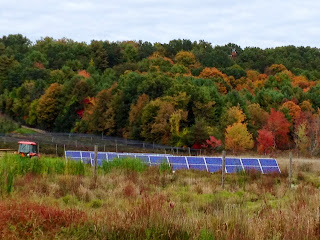 |
| Fall foliage and solar photovoltaic panels at Cider Hill Farm in Amesbury, Massachusetts. |
EIA projects a continued increase in the consumption of renewable energy in the forms of electricity and heat generation. Overall, in 2013 EIA expects 4.5% growth over 2012's renewable energy consumption, with further growth of 2.3% in 2014.
EIA also predicts shifts in the resource mix providing this renewable energy. In 2013, EIA expects a 1.5% decline in hydropower production, offset by 8.3% average growth of nonhydropower renewables used for electricity and heat generation. In particular, EIA expects 2.5% growth in wind capacity this year, reaching a total installed capacity of about 61 gigawatts from wind. This capacity is predicted to enable generation from wind to increase 19% in 2013 and another 2.4% in 2014, at which point it is expected to reach over 4% of all electricity generated in the U.S.
Solar energy is expected to grow more sharply, but will remain a relatively small segment of the nation's overall energy portfolio. EIA expects solar generation by the electric power sector to increase a staggering 79% in 2013 and 80% in 2014. In recent years, customer-sited distributed generation projects have led the charge in new capacity additions, but EIA expects utility-scale projects to more than double in total installed capacity between 2012 and 2014. Most of this new utility-scale solar capacity will continue to come from photovoltaics, but several large solar thermal generation projects may come online the next two years. Despite this relative growth, the small absolute size of the U.S. solar market means that solar energy will only account for about 0.3% of energy consumed in 2014.
When 2013 has ended, will EIA's predictions come true? We will learn in several months.


No comments:
Post a Comment